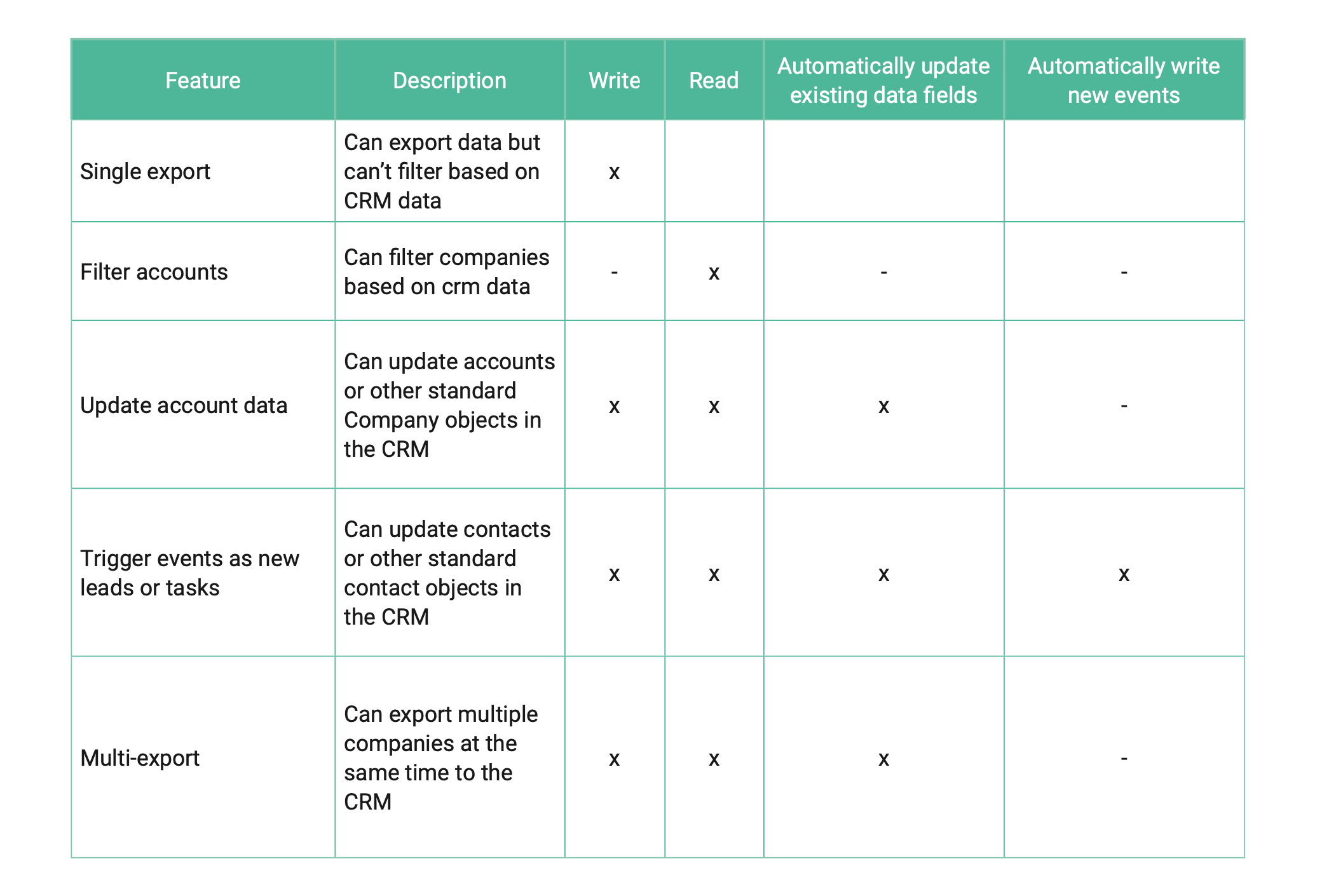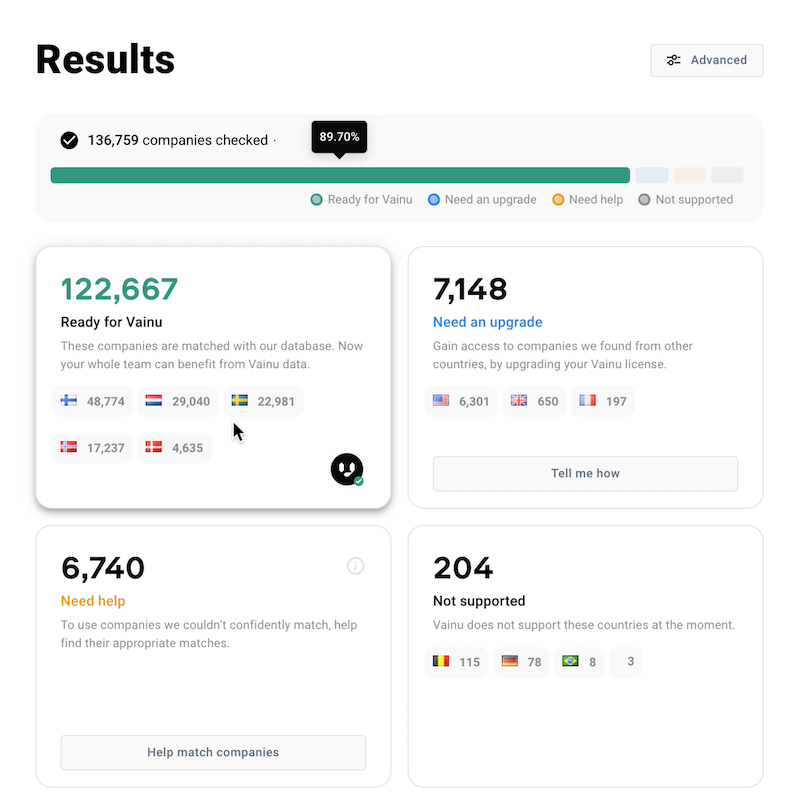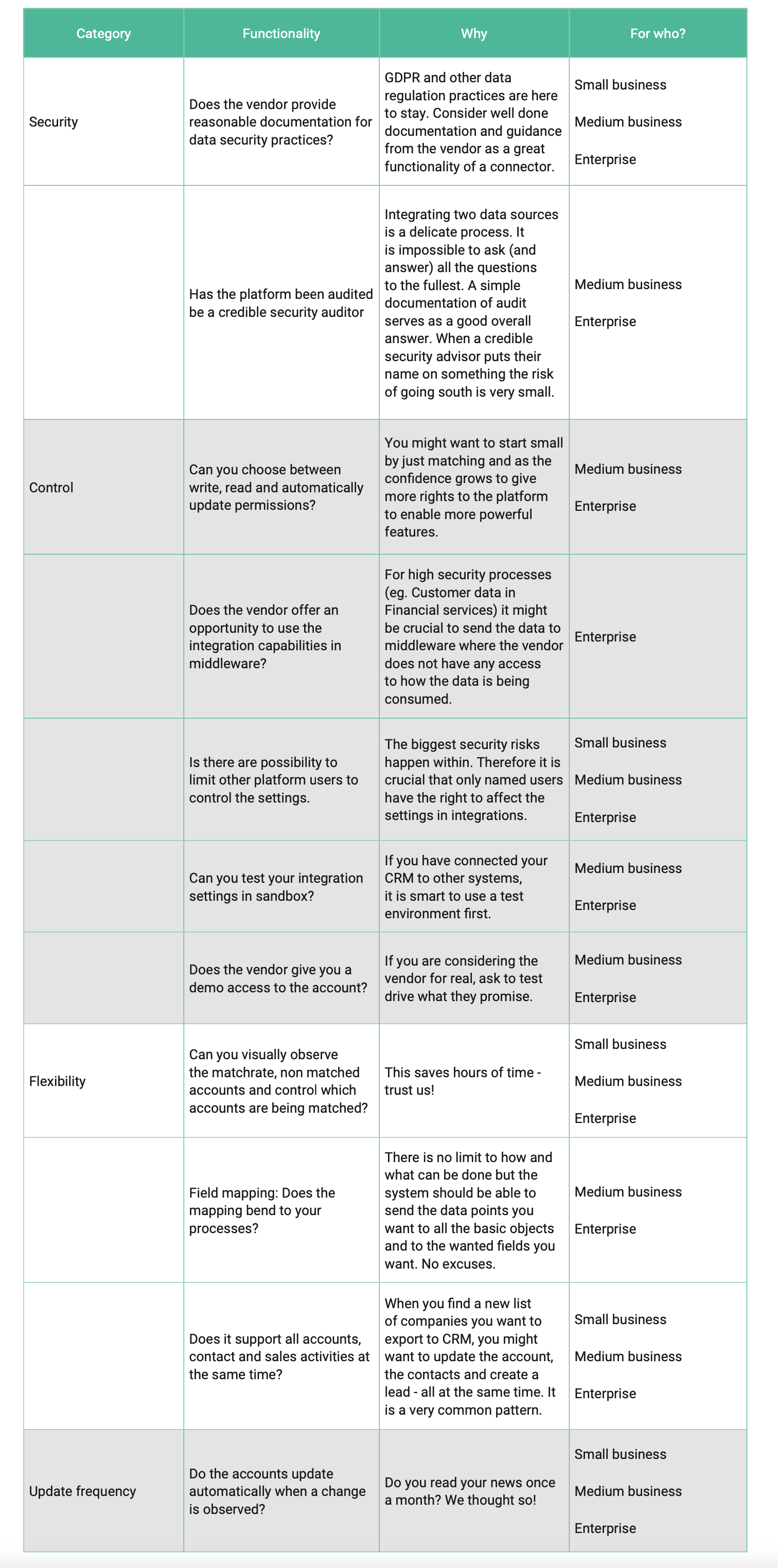The Inner Workings Of A CRM Data Update
While CRM software is powerful on its own, integrating it to other tools across your sales tech stack expands its functionality and makes your job much easier. Ideally, your CRM should serve as the central hub of all your sales activities: it should gather, organize, and analyze all the data on your accounts.
One way of feeding relevant information into your CRM is connecting to a data-rich sales intelligence platform that will provide insights into prospects' and existing clients' daily business. After all, there's no shortage of information on pretty much any company in the world today. This process is known as data enrichment or data update.
On paper, the process is simple. The only requirement is to connect a couple of databases and transfer a few data fields. In practice, though, it can get a bit more complicated than that.
In this post, you’ll learn about the five things you need to pay attention to when enriching your CRM data. You’ll also read about how our team at Vainu plans and prepares these projects, safeguarding your CRM data and ensuring the information is always fresh and reliable.
Let’s dive into it.
What’s a CRM data update?
First things first. By CRM data update, we refer to the process of enriching records with data points that are missing, updating existing ones, or adding new fields of interest. Data updates occur automatically behind the scenes (or manually) when a CRM system is connected to a source of company information, such as Vainu.
Once a CRM data update process is up and running, salespeople can reduce the time spent updating the CRM and focus on what they do best—selling. Not only will sales teams avoid manual data projects, but they will also have access to up-to-date information that allows them to draw reliable insights and subsequently boost performance.
CRM data update: How to get started
The easiest way to update your CRM database is with a CRM integration. You can connect a sales intelligence platform to your CRM and generate insights on your customers and prospects by expanding what you know about your customers.
Knowing that the mere thought of altering your valuable CRM database sends chills down your spine, we've written this article to go through the five different elements that you need to take into account before embarking on a CRM integration project.
- Security - Understand the data you're bringing to the CRM and how third-party systems process it. In addition to the technical implementation, you need to consider the legal aspects of processing the data.
- Control - Always keep a firm grip on how and what data points are integrated. You want to know how much of your company's internal data needs to be distributed to third-party applications for processing.
- Flexibility - You should be able to modify any CRM integrations based on your own needs. Third-party company data providers need to adapt to your CRM strategy and how your tech stack works. Not the other way around.
- Scalability - Integrations enable automation. Your systems must allow high volumes of data to change constantly.
- Frequency - Seriously, still out there doing one-time batch updates? In a rapidly changing world, data updates must happen in real time.
5 components of a successful CRM data update project
1. Security
To get the most of Vainu's technology, we must establish a connection between Vainu and your CRM. Such connection requires read and write access to your CRM. This way, your CRM will be both a source of data (to allow filtering and segmenting using CRM parameters) and a destination of data (to export our data to your CRM). Without read and write access, it wouldn't be possible to work with data.
Because we work with sensitive information, we've taken into account all necessary data privacy requirements. When it comes to personal data found in our database, we act as controller. Similarly, you become a controller of the data exported and repurposed from our database to your CRM. You must understand the responsibilities of the controller. When we connect Vainu to your CRM and read the data, we process your CRM account owner and other personal information in the role of a processor.
How we process the account owner information depends on how you have organized and created your CRM owner accounts. Such information may be your employee ID number, email address, or other ID, which may not be considered personal data according to GDPR. Should the account owner be considered personal data, you should understand where such data lives. Where are the servers? Is the data processing happening within the EU and according to EU legislation? In our case, we store all CRM information, including the account owner data, in MongoDB and Amazon AWS servers in Ireland. The data lives in the EU.
2. Control your data
To backup your photos to the cloud, your phone’s software needs your permission to read and transfer your files. Otherwise, the phone won’t be able to transfer the files to the destination servers. Similarly, as mentioned above, to use the Vainu connector to the full extent, you need to grant our software permission to read your CRM database. Only then is the technology able to match all the relevant data and sort companies based on your CRM activities.
The following table explains the permissions needed for each feature of Vainu’s CRM integration.

3.Flexibility
CRM projects start with a vision. First, you need to figure out what problem you’re trying to fix. Then, you implement the tools—the software—to solve those problems. In practice, this means any CRM integration or data update process must adapt to your processes—not the other way around.
Whatever your goals, you’ll need a clean and tidy CRM, organized around unique identifiers. Here’s some best practices.
Account matching
Data updates require that you merge information sourced from different databases. For example, company A in your CRM platform must receive information about company A from a sales intelligence provider. This sounds obvious, but when you update hundreds of data fields and thousands of accounts, a small mismatch will lead to duplicates and erroneous data. And you don't want bad data cluttering your CRM platform.
To achieve the highest possible matching rate, a CRM data update requires finding a unique identifier for each CRM record or account. Typically, this unique identifier is the business IDs or VAT codes. Not all CRM platforms are organized this way. Some may use company names or website domains as unique identifiers.
Our integrations use multiple fields for matching:
- City
- Country
- Business ID
- Phone
- Company name
- Address
- Postal code
Domain ID vs. business ID
Many tools choose to use a web domain as the unique identifier of an account. The main difference in domain versus business ID matching is that a domain is not a legal entity, and no official data can be attached. This creates a challenge in integrating to other systems, for example, billing systems. You can't bill a domain.
However, there are also advantages to domain-based matching. Companies that have domains as unique identifiers are not official companies as such but rather representations of them. As such, you don't need to be very strict about what data to append. It's also effortless.
But, if you want to run a data-driven business using company data, you want to link accounts to a business ID—it unleashes many possibilities since the whole company universe can be attached to it.
If you are new to your CRM or your data isn’t organized in the best possible way, we suggest organizing your data based on business IDs only. Further down the line, it’ll be much easier to attach the domain ID on top of a business ID than the other way around.
Always prioritize business IDs
The best option is, of course, to use business IDs and domain ID together, so you can use the domain information to identify companies that belong to the same corporate group (as “GroupID”). However, if you are new to your CRM or your data isn’t organized in the best possible way, we suggest organizing your data based on business IDs only. Further down the line, it’ll be much easier to attach the domain ID on top of a business ID than the other way around. With neatly organized CRM accounts, you can create data-driven target groups and other advanced features on top of your data.
If you decide not to organize accounts based on business IDs, you need to define your unique identifier first. Often domains are used as unique identifiers, such as in Hubspot insights. Before connecting Vainu to the CRM, we need first to define what a company or an account is. Is it the whole group (Volvo Group), the country organization (Volvo Finland), or the branch (Volvo Automotives)? It often happens that when your customer base grows, you might end up with 300 Volvo accounts with no clear relation between them. This situation is one of the major causes of data decay. You can see why business IDs are the preferred option as the primary identifier of an account—it’s a widely accepted taxonomy.
You can opt to define an account based on the whole corporate group instead of individual companies. In this case, matching records based on a domain is very simple. If your CRM usage is specific about this, we suggest creating custom objects that will be the destination of company data. Then, these objects will be linked to the accounts in your CRM.
High matching success rate
Once you've matched the accounts and mapped the fields, it's time to flip the switch—unfortunately, there won't be any fireworks to signal the end of the process. Data fields will have a plethora of new information, but how can you be sure of what happened? How many companies matched, and which ones were left out? How many fields were updated?
A good dashboard will answer those questions. Here’s the information Vainu reveals after a CRM data update:

Field mapping
At its core, a CRM platform is just a database formed by records with multiple data fields. Not every organization needs the same amount or the same type of data fields, so before company information flows between systems, you want to decide which fields you’ll be updating or creating. This is known as field mapping.
Typically, you want to group data fields into three categories:
- Account data—anything that relates to a company
- Contact data—anything about the contact personas at an account.
- Leads/Tasks/Opportunities/Deals—anything that is related to taking a sales process forward.
Some data fields, such as “zip code” or “postal address,” are unequivocal and as a result, source and destination will easily match. When it comes to more complex data sets, a well-thought-out field mapping process is pivotal.
If you’re considering a CRM integration, a simple way to find out about the product’s scalability is to ask a vendor this question: “Can you name any enterprise-level customers that have connected over 100k accounts with your connector?” Enterprises don’t take integrations lightly.
4. Scalability
There is a huge difference between matching and keeping up to date 1,000 accounts and doing it the same for one million accounts from different geographies while sending new tasks and leads in real time. Whenever you’re planning a CRM integration and data update, ensure you can quickly scale the process.
System stability is key, and the integration’s backend design plays a considerable role here. This aspect can get very technical and requires a fully-fetched product team to think it through.
If you’re considering a CRM integration, a simple way to find out about the product’s scalability is to ask a vendor this question: “Can you name any enterprise-level customers that have connected over 100k accounts with your connector?” Enterprises don’t take integrations lightly. They act as due diligence to your decisions.
Some benefits are very tangible. When you feed the right data and signals (trigger events) into your CRM, you can automate task creation and speed up your sales process.
5. Frequency—Real time, of course!
We tend to say that integrations are the enablers of automation. When a powerful company data platform fully integrates with your other business systems, such as CRMs, it supercharges a sales organization.
Some benefits are very tangible. When you feed the right data and signals (trigger events) into your CRM, you can automate task creation and speed up your sales process. Your sales team can stay on top of the accounts in real time. We call this modern approach to sales “personalization at scale”—a method where real-time company information is used to ensure that each account is treated on its own terms.
In the past, you needed to compromise either the quality or quantity of the sales process. Today, thanks to the vast company information readily available, you can easily draw meaningful and reliable account insights. CRM integrations and data updates ensure that salespeople can access those insights where and when they are needed. When the integration takes care of the grunt work, salespeople will have the insights they need for personalized outreach. And, all that without any manual work.
CRM data updates is a process that never stops. Companies are in flux, and changes happen all the time. That’s why Vainu’s data is updated in real time. Once connected to a CRM platform, users will see fresh and reliable information whenever they log into the CRM. Whenever one of your contacts hires a new director or changes office, the information will be added to the right account in your CRM. FTP servers, batch updates, data dumps, or CSV export are a thing of the past.
Test and revert
Matching and updating massive amounts of data are complex tasks. Any small error can generate major headaches. Be careful if you have other systems connected to your CRM. It might be that business IDs are read with the character “-” (e.g. 2557864-2) while another integration skips that character (“25578642). Vainu’s CRM integration offers different options to match crucial fields according to the user's preferences and, therefore, avoid mismatches and errors. Our matching technology is smart enough to detect those different business ID formatting options and apply a unified format.
To avoid these errors, it is vital to test your integration before going live, either in a test environment or a sandbox. This is as obvious as it gets, but testing capabilities should be included in any CRM integration worth its salt.
But...what happens if something goes wrong? This is the last question—and probably the most sensible one—before proceeding with a massive CRM data update. The more advanced CRMs have sandboxes and backups to cover that. Can you count on those? We recommend to start a data migration project with internal stakeholders. You might need extra permissions for the sandbox environment. Ensure you know how the backup works so that it doesn't affect something else.
During Vainu’s data update projects, we add an extra layer of security and control. Again, working with company data and CRM is too sensitive, so we don’t leave anything to chance. Revert functionality is an important aspect of being comfortable in matching our data with yours.
Finally… let’s go shopping for a CRM data update
Now that you know how a CRM data update works, you can more confidently go to the market and shop. We’ve prepared this checklist to guide you through the main elements to consider when purchasing an integration that will enrich your CRM data.


